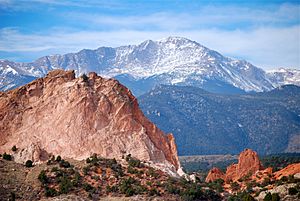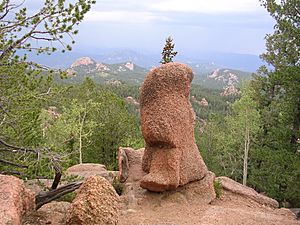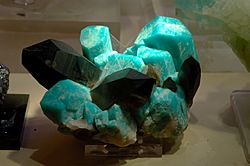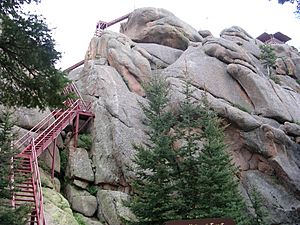Mineralogy of the Pikes Peak Region facts for kids
The Pikes Peak region is a super cool place for finding rare and beautiful minerals! It's a favorite spot for people who love rocks, from casual collectors to serious scientists. Experts from all over the world come to Colorado to study the amazing minerals found here.
The Pikes Peak granite, which is a type of rock, covers a huge part of Colorado's Front Range. This means there are many great places to collect minerals all around the Pikes Peak area. These spots stretch from near Colorado Springs in the south to just west of Denver in the north.

Contents
How the Rocks Formed
The Pikes Peak granite formed over a very long time, starting about 1.02 billion years ago! Imagine a huge blob of hot, melted rock, called magma, pushing its way into the ground where the Colorado Front Range is now. Most of this magma didn't reach the surface to make volcanoes. Instead, it cooled and hardened deep underground, about 1 to 2 miles (1.6 to 3.3 km) deep. This underground rock mass eventually covered a huge area, about 1,200 square miles (3,100 km2)!
Over the next 40 million years, more magma pushed into the existing granite. This new magma melted and pushed aside the older rock, creating special spots called "intrusive centers." These centers often formed circular rock masses with different layers, kind of like a bullseye target. The granite in these centers is different from the original rock. It has more rare elements and unusual minerals. Some of the best places to find minerals in Colorado are right around the edges of these special centers.

When a new wave of magma pushed up, its edges cooled quickly where it touched the older rock. This formed a "skin" of fine-grained granite. Because this "skin" was less porous (meaning it had fewer tiny holes), it helped trap rare elements and water inside the magma. Over time, this water and these rare elements became very concentrated along the edges of the magma.
As the magma cooled and turned into solid crystals, the amount of water in the remaining liquid magma grew rapidly. This is because molten magma can hold water, but solid crystals can't. So, as each crystal formed, it pushed out the water it contained. The more crystals that formed, the more water got squeezed into smaller and smaller amounts of magma.
When water and certain elements became concentrated along the edges of the magma, even larger crystals started to grow. At the same time, the water helped create open spaces called miarolitic cavities. These pockets are super important because they let crystals grow freely without bumping into other crystals or the surrounding rock. While you can find good crystals in solid rock, the most perfectly shaped ones usually come from these miarolitic cavities.
Because the intrusive centers were often circular and cooled from the outside in, certain minerals gathered in ring-shaped zones around the edges. For example, in the Tarryall region, most of the topaz is found near the edges of the intrusion.
Mineral Collecting Hotspots
There are seven main areas within the Pikes Peak granite where you can find minerals. All these spots have similar basic minerals, mostly smoky quartz crystals and amazonite. You can also find topaz, phenakite, and other rarer minerals in certain places. Even though they share common minerals, each area is unique and tends to have more of certain minerals than others.
Here are the collecting areas, starting from the ones furthest south:
Gold Camp Road
The Gold Camp Road is an old railroad path that goes from Colorado Springs to Cripple Creek. It was one of the three railroads that served the Cripple Creek Mining District around 1900. You can get there from Colorado Springs by driving up North Cheyenne Cañon.
The collecting areas begin near Helen Hunt Falls and go south to St. Peter's Dome and north to the High Drive. Besides the usual smoky quartz and amazonite, the Gold Camp Road area has several minerals that are quite rare in other parts of the region. You can find lots of fluorine minerals like fluorite and even rarer ones such as cryolite, bastnäsite, and tysonite. Some spots also have the rare amphibole riebeckite and the even rarer mineral astrophyllite. Plus, you might find large, colorful zircon crystals in a few places.
Crystal Park
North of Gold Camp Road is Crystal Park. This park is on the eastern side of Camerons Cone, a 10,700 ft (3,261 m) peak southeast of Pikes Peak's summit. Just east of Camerons Cone, the mountains form a protected, bowl-shaped valley called Crystal Park. You can reach it by a good road from Manitou Springs or by trails from the southeast and east. Today, much of the park is a private housing area. The collecting spots stretch from the northern slopes of Camerons Cone to Specimen Rock in the south. A lot of this area is National Forest land.
Like other Pikes Peak collecting areas, Crystal Park has the common smoky quartz and amazonite crystals. But here, you'll find more topaz than in the Gold Camp Road area.
Pikes Peak
Pikes Peak itself is an intrusive center. You can find smoky quartz and amazonite in many spots within four miles (6 km) of the summit. For example, amazonite can be found near Barr Trail, which is the main hiking path to the top of Pikes Peak. The most famous collecting spot on the Peak is Glenn Cove. This is a glacial cirque (a bowl-shaped valley carved by a glacier) located at 11,000 ft (3,353 m) on the north side of the mountain. You can find quartz crystals, amazonite, and topaz crystals in pockets on the steep cliffs here.
Crystal Peak
Crystal Peak is about 35 mi (56 km) west of Colorado Springs on Highway 24. It's north of the highway, between Florissant and Lake George. Crystal Peak itself is a unique, cone-shaped hill about 3.5 mi (5.6 km) north of Florissant. Geologically, it's also an intrusive center, and maps show a very clear ring-shaped structure about 5 mi (8 km) across.
Like Crystal Park, the eastern part of the Crystal Peak area is on private land and has been turned into a housing development. However, the western and northern parts of the region are on National Forest land.
Crystal Peak is one of Colorado's most famous mineral collecting places. Specimens from here are sometimes said to come from Lake George or Florissant, but the actual collecting area is near Crystal Peak. This area has produced some of the best smoky quartz and amazonite specimens in the world. It's especially known for specimens that combine deep black smoky quartz crystals mixed with deep blue amazonite. Other minerals like topaz, fluorite, and goethite have also been found here.
Tarryall Mountains
The Tarryall Mountains are about 12 mi (19 km) north of Lake George. They are an intrusive center called the Redskin Stock. Like the other places in the region, smoky quartz and amazonite are the main minerals. However, the amazonite here is usually very pale and often blends into ordinary pink or white microcline feldspar.
The Tarryall Mountains are famous for being one of the best places to find topaz in the region. You can find topaz in the typical pegmatite veins and pockets (rock formations), but also in placer deposits. These are places where flowing water and gravity have sorted the slightly heavier topaz to the bottom of gravels.
Devils Head
Devils Head is about 33 mi (53 km) south-southwest of Denver on the Rampart Range Road. Like the other locations, Devils Head is another intrusive center. It forms a noticeable 9,700 ft (2,957 m) peak whose tall rock formations are easy to see from Denver.
The main collecting areas are on the west side of the mountain. They have the usual mix of smoky quartz and amazonite. However, similar to the Tarryalls, the amazonite here is usually very pale and often blends into plain microcline.
Devils Head is most known for its large topaz crystals and even bigger smoky quartz crystals. Perfect, gem-quality crystals of deep black smoky quartz, several feet long, have been found in this area.
Rosalie Lobe
The Rosalie Lobe is on the southeast slope of Mount Evans, a prominent 14,000 ft (4,267 m) peak just west of Denver. The Rosalie Lobe is interesting because it's a separate part of the Pikes Peak Granite, about five miles away from the main body of the rock. You can get to it from Highway 285 from the town of Harris Park, which is about 30 mi (48 km) southwest of Denver.
The Rosalie Lobe has the same minerals found in the intrusive centers further south, especially smoky quartz, amazonite, and topaz.
Images for kids









